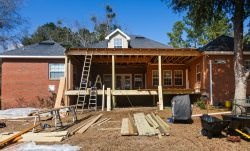Abo ut 85 percent of all single-family homes in the U.S. include a deck or deck-like structure, which is equivalent to roughly 30 million decks. Sixty percent of all new homes are constructed with a deck, while nearly 2.75 million decks are replaced on an annual basis. That’s according to Cintrafor.org’s research… and that’s a lot of decking! So naturally there are a lot of opinions on the best way to build a deck.
ut 85 percent of all single-family homes in the U.S. include a deck or deck-like structure, which is equivalent to roughly 30 million decks. Sixty percent of all new homes are constructed with a deck, while nearly 2.75 million decks are replaced on an annual basis. That’s according to Cintrafor.org’s research… and that’s a lot of decking! So naturally there are a lot of opinions on the best way to build a deck.
No regrets.
The best builders want complete satisfaction. You may want an 8’x8’ deck, but did you really consider if that is the appropriate size? Give the layout a trial by using stakes and string - or even baking flour - to outline the deck’s footprint. Then, place your furniture, grill, flowerpots, etc. around to make sure that you like the shape, clearance around objects, and traffic flow.
Straighten those bowed deck boards.
No matter how good your lumber supplier is, a good share of your decking is sure to be bowed. Straightening bowed boards is a routine part of deck construction. The Family Handyman likes to set the board, bow in, and nail one end. Work toward the other end, nailing as you go.
Trim deck boards dead straight.
Beauty is in the details. Using a board to guide your saw as you trim your decking leaves an edge crisper than the steadiest hand can make. This is another tip from the Family Handyman for that final trimming. Attach a guide, and screw a straight board to the decking as a guide for your circular saw. Measure the distance from the edge of the saw blade to the base plate and position the board to allow about a 1-in. overhang for the decking. Run your saw along the edge, keeping the saw blade parallel to the decking and tight to the guide.
Choose the appropriate fastener.
Experts warn to always follow manufacturer guidelines for appropriate fastener types and sizes, and use stainless steel or galvanized fasteners if you are using pressure-treated lumber. The INVISIDECK® Hidden SCRAIL® Fastener System was designed for grooved and non-grooved board applications. It dramatically reduces time and cost while creating smooth decking surfaces free from any visible fastener heads, and is the perfect fastener for all of your decking needs.
Avoid mistakes.
There’s no shortage of ideas for design and construction. Everyone seems to have an opinion on what to do when you build a deck. Avoiding mistakes can be a crucial element to success, and learning some of these ahead of the game should help you prevent costly errors.
.svg.png)
